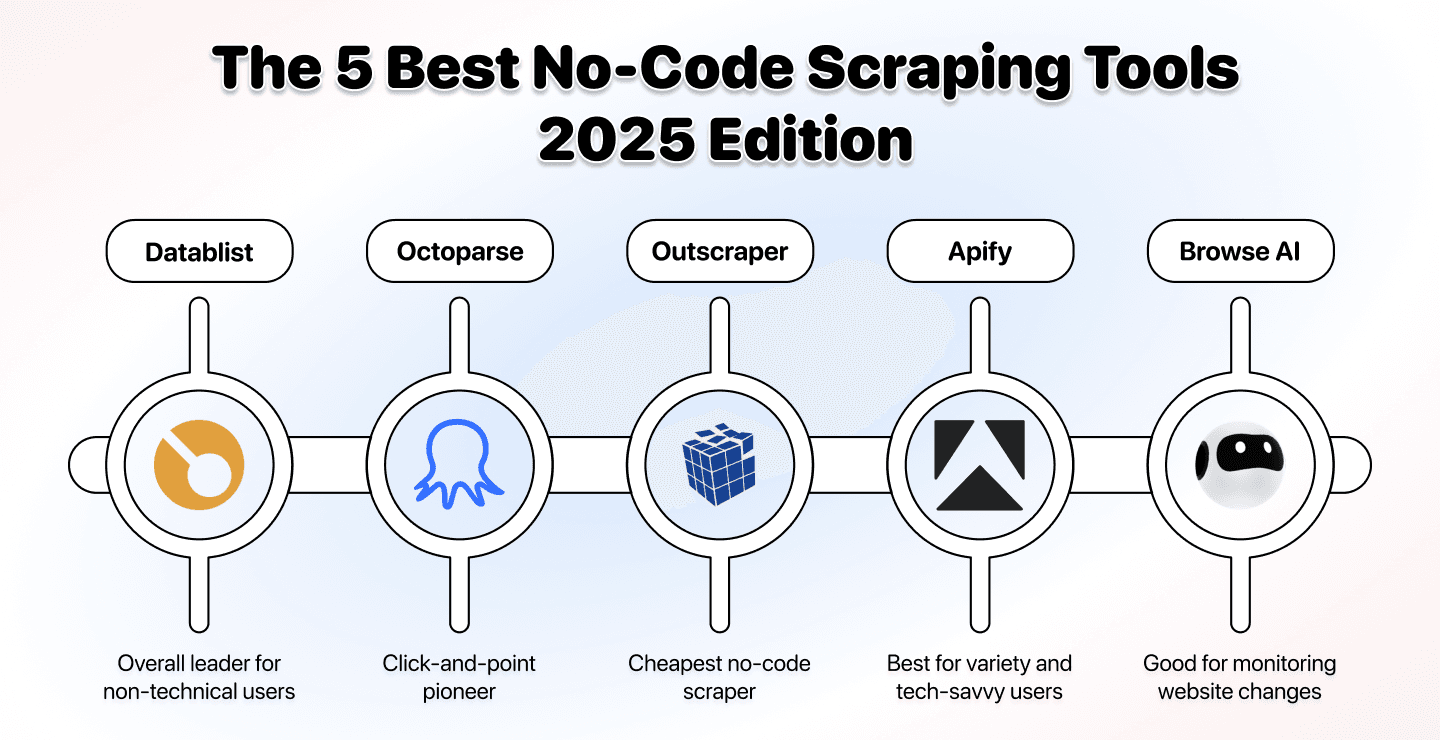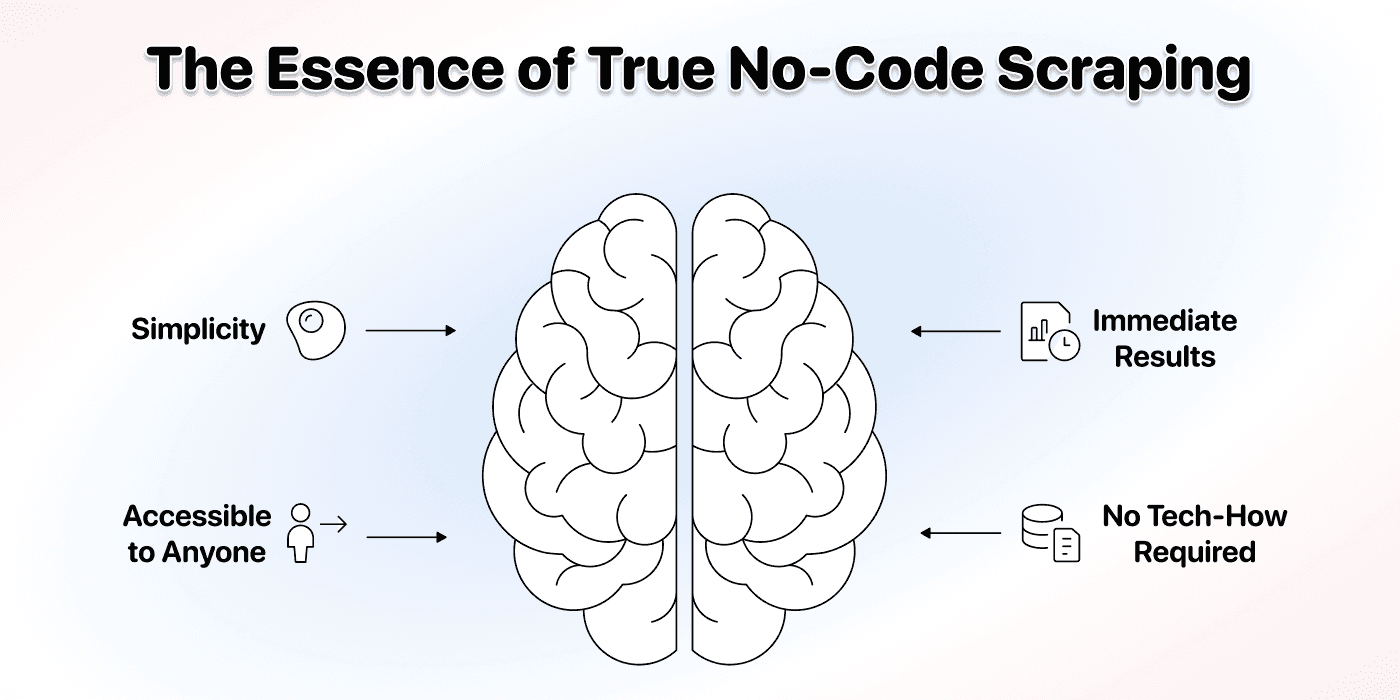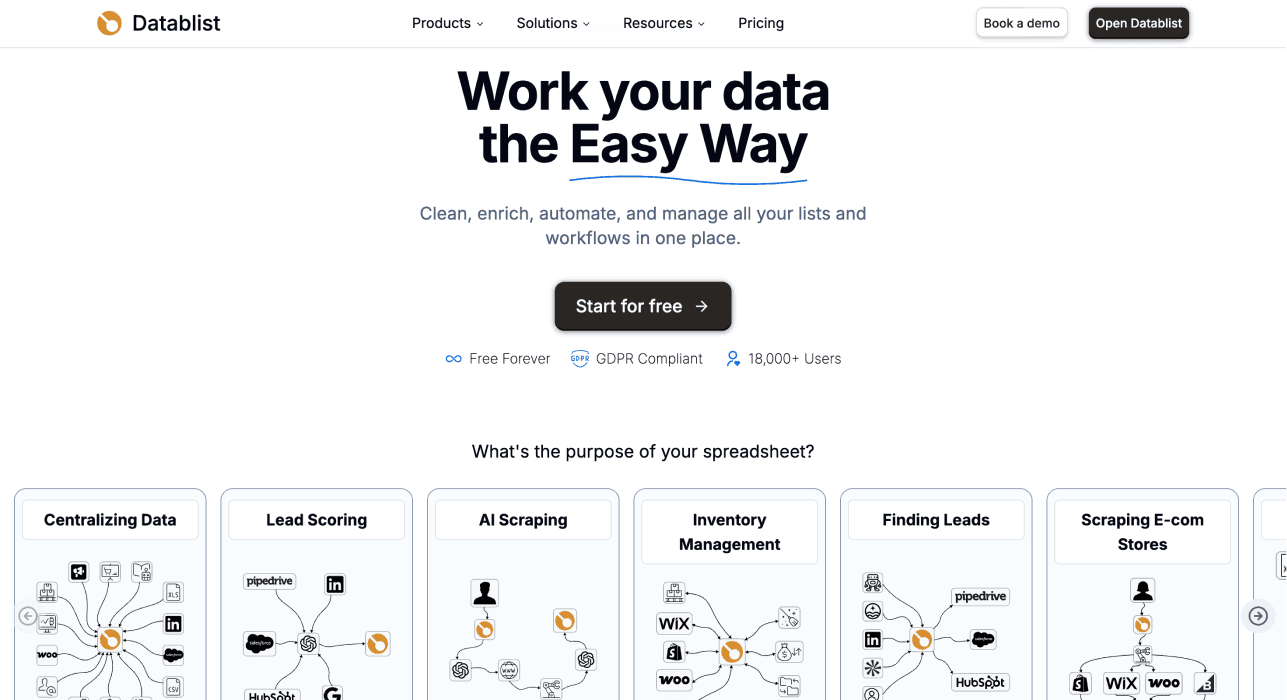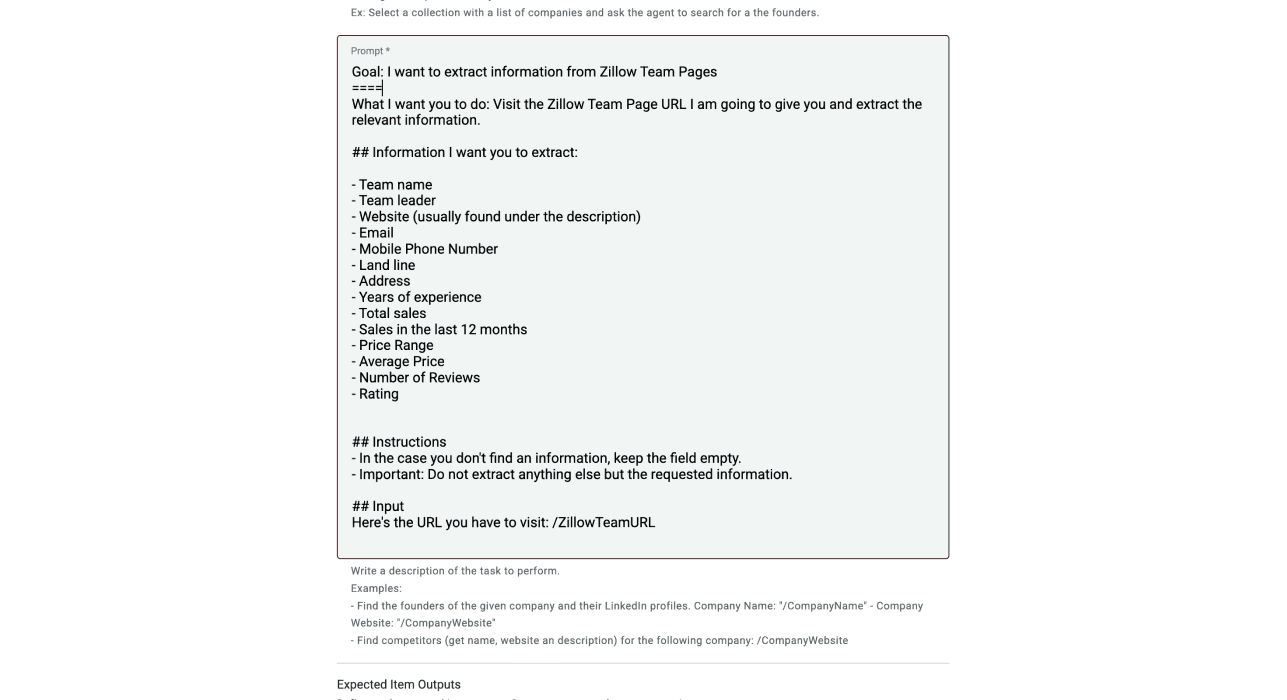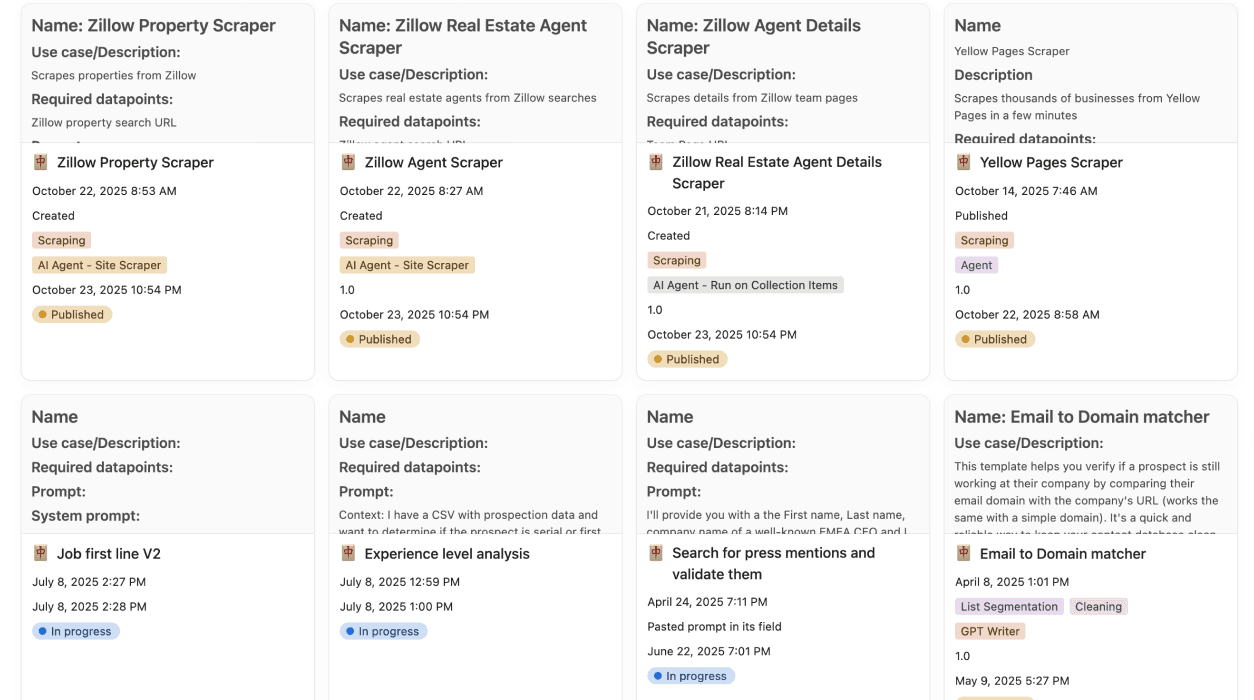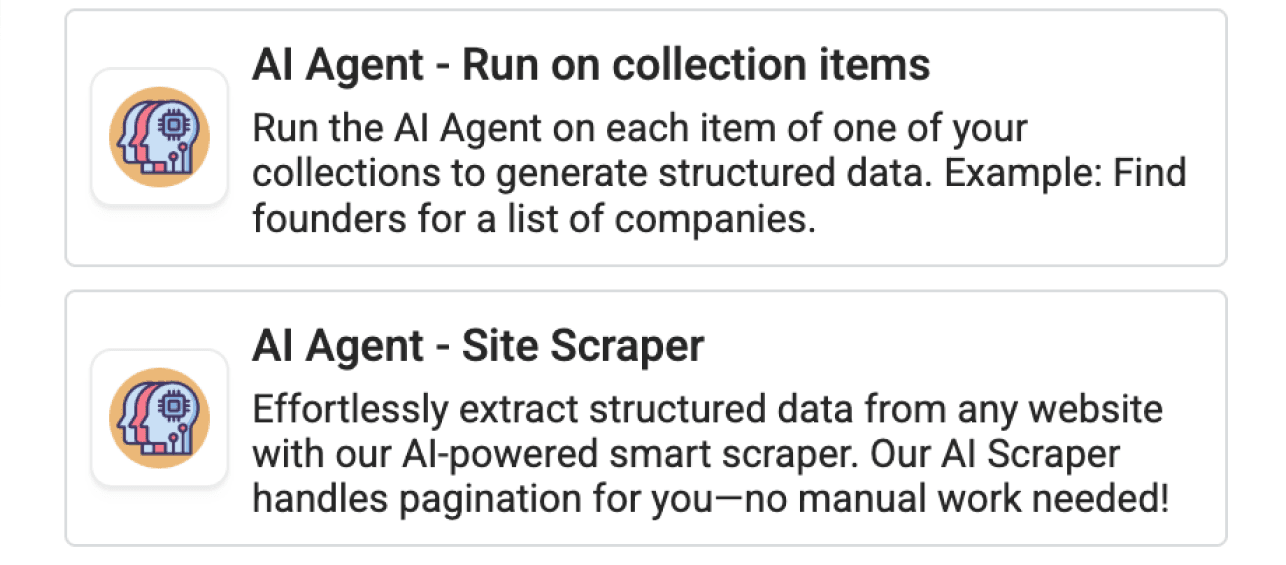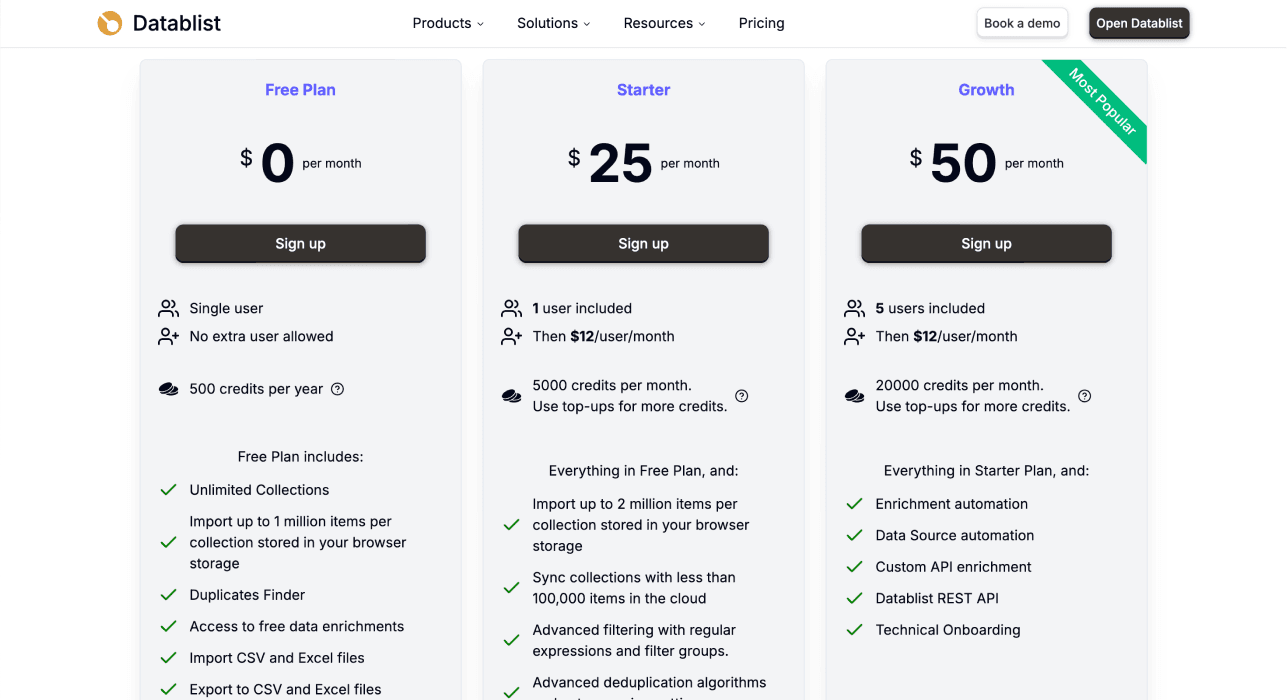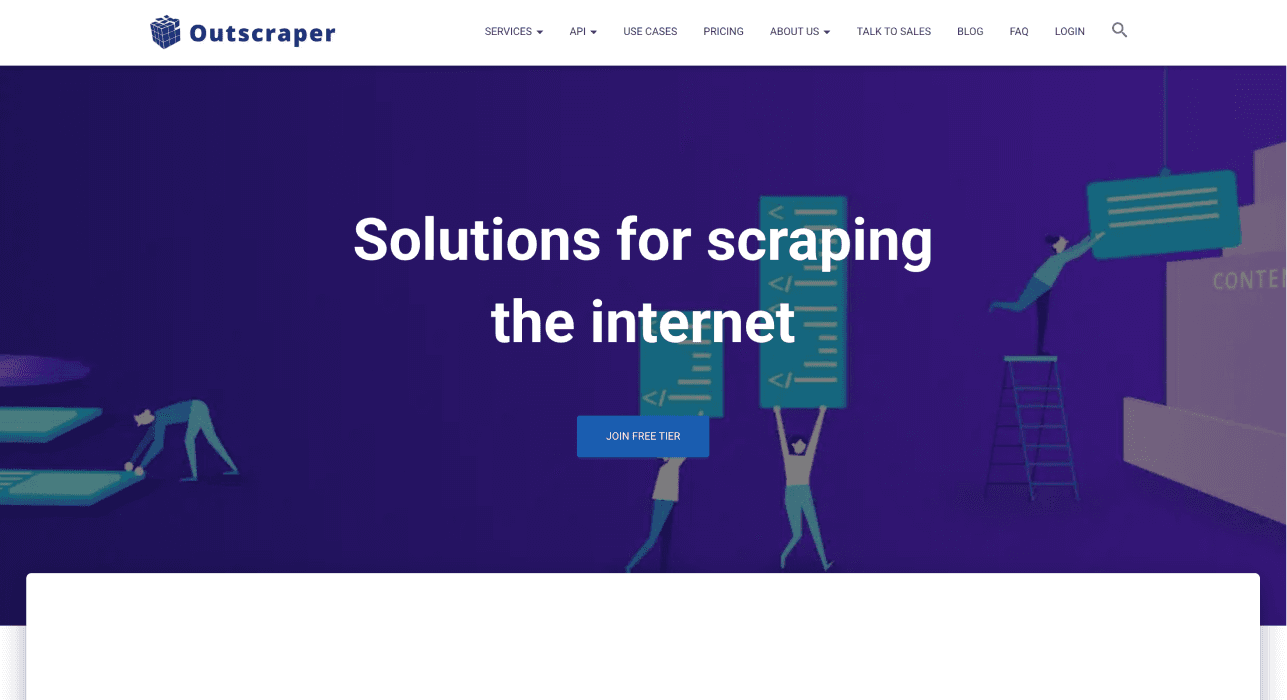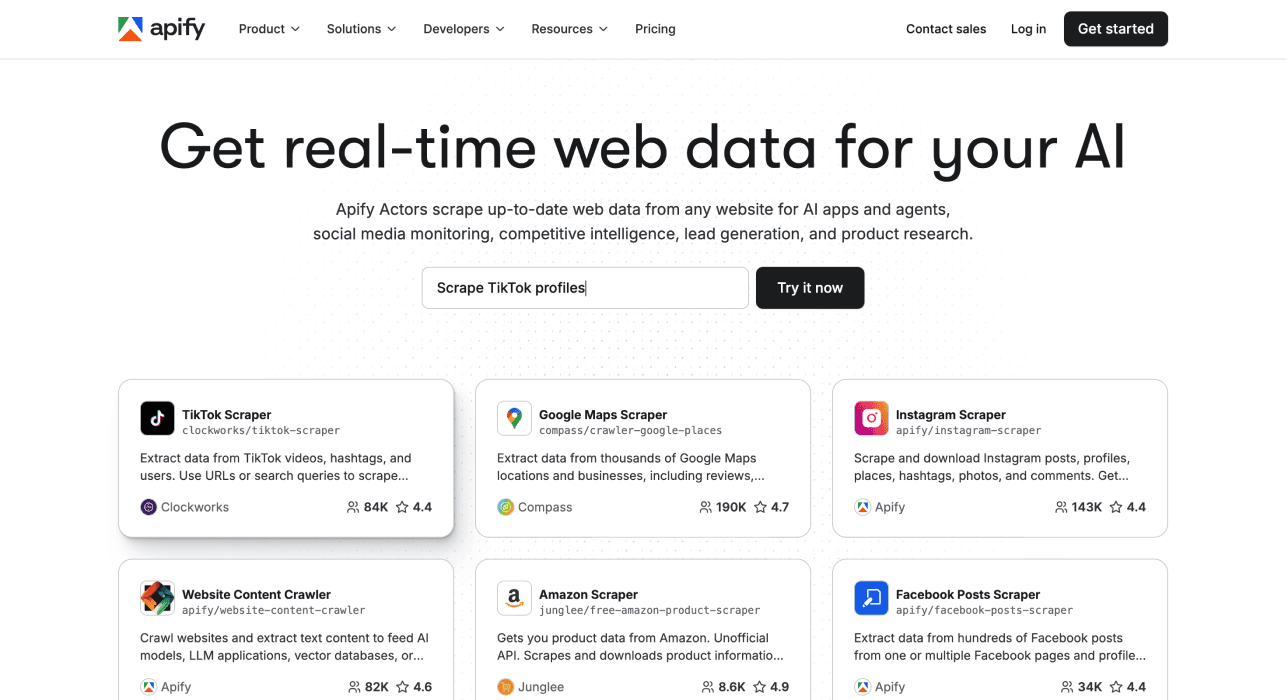I’m about to make a bold but confident claim.
This article will change how you evaluate and think about no-code scraping tools. Here’s why:
AI changed everything we know about no-code scraping, but most people are still using old assessment methods. When the game changes, the rules should change too.
Let’s get into the details.
📌 Summary For Those In a Rush
This article ranks the best no-code scraping tools using new, user-centric benchmarks instead of comparing them to coding. If you are in a rush, here is a summary:
Problem: Most comparisons of no-code scraping tools use outdated benchmarks that compare tools to coding instead of true ease of use.
Why it's a problem: When you search for a no-code tool, you want something as easy as boiling eggs, not something that's just "easier than Python."
Solution: New benchmarks that measure true user-friendliness (3-step simplicity), usefulness (what can it actually do), and pricing (affordable for individuals and small teams).
What You'll Learn: How to evaluate no-code scraping tools using the right criteria, detailed reviews of the top 5 tools, and which tool is best for your specific needs.
The Rankings:
- Datablist - Best overall for non-technical users
- Octoparse - Click-and-point pioneer
- Outscraper - Cheapest entry point
- Apify - Best variety for tech-savvy users
- Browse AI - Best for monitoring website changes
What This Article Will Cover
- Best No-Code Scrapers at a Glance
- A New Way to Define "The Best Tool"
- Detailed Reviews of the Top 5 No-Code Scraping Tools of 2025
- Frequently Asked Questions About No-Code Scraping Tools
The 5 Best No-Code Scrapers at a Glance
| Tool | Best For | Ease | Power | Price | Killer Feature |
|---|---|---|---|---|---|
| Datablist | Plain English scraping, complete ecosystem, flexibility | ●●●●● | ●●●●● | $25/mo | "Scrape this and get me emails" actually works |
| Outscraper | Google Maps, Yellow Pages, cheapest option | ●●●● | ●● | $10 | $10 entry, no commitment |
| Octoparse | Visual interface, desktop app, tutorials | ●●● | ●●●● | $83/mo | Best click-and-point interface |
| Apify | Huge variety, technical flexibility, almost any site | ●● | ●●●● | $49/mo | 1000+ pre-built actors |
| Browse AI | Website monitoring, price tracking, alerts | ●●● | ●●● | $49/mo | Real-time change detection |
🏆 The Winner
For most people: Datablist wins because it's the only tool that's truly no-code (plain English), works on any website, and includes 60+ lead gen tools at the best price point (just $25/mo)
Buyer Guide: Make Better Decisions By Redefining "The Best Tool"
Let's start with what I believe is the most important section, and when I say this is the most important section, it's because it shows you what the standard for no-code tools should be.
If you already have your own decision parameters prepared, feel free to jump to the tool comparisons. If not, then think about this for a moment: Most of the "best no-scraping tools" articles you see online are irrelevant and don't keep up with the times.
Let me explain the fundamental problem:
↳ We defined "easy to use" wrong for too long (the most important thing for no-code scrapers)
↳↳ Ease of use shouldn't be compared to coding anymore, but to boiling eggs or tying shoes
↳↳↳ When you search for no-code scraping tools, you don't want easier than Python
↳↳↳↳ You're looking for something that requires zero technical know-how.
↳↳↳↳↳ AI scraping delivers that by letting you scrape in plain English.
Then you have, of course also usefulness and pricing, which are important too to determine which tool is the best no-code scraping tool of 2025.
Ease of Use: The Boiling Eggs Benchmark
Most of the time, ease of use is compared to coding. For non-technical people, this doesn’t make sense. In this article, I'll do it differently; I'll compare ease of use to boiling eggs.
The process of boiling eggs is one of the simplest things on earth:
- You put eggs in water
- Wait X minutes based on how hard you want them
- Take eggs outThat's 3 steps to boil eggs.
This is the new benchmark for ease of use: 3 steps, everything above that gets a point deducted.
True No-Code or Not?
The second part of ease of use is whether you have to learn a new technical skill to use it.
True no-code means:
- No understanding of HTML, CSS, or JavaScript required
- No learning about DOM structures or selectors
- No watching hours of tutorials just to get started
- No technical jargon
If a no-code scraping tool forces you to understand website architecture, point at HTML elements, or configure CSS selectors, it's not truly no-code. It's just code dressed up in a prettier interface.
Usefulness: What Can You Actually Do With It?
Usefulness of a tool is pretty simple to define: What can you do with it?
We'll evaluate based on the most common things people want when choosing a scraping tool:
- Scraping complex sites
- Getting a lot of data
- Automating recurring tasks
Advanced Scraping Capabilities
Can the tool handle:
- JavaScript-heavy websites that load content dynamically?
- Paginated results across multiple pages?
- Complex navigation and multi-step processes?
JavaScript rendering is one of the biggest technical challenges in modern web scraping since over 70% of modern websites rely on JavaScript to load content dynamically. The more complex the sites you can scrape, the more useful the tool.
Integrations & Ecosystem
No one scrapes data for fun; you scrape data to use it to grow your business. Therefore, it just makes sense that you should be able to use the data you get from the tool without juggling 10 different platforms.
With that being said, the best no-code scraping tools offer:
- A variety of scrapers for different use cases
- Integration with other tools in your workflow
- Enrichment capabilities (finding emails, phone numbers, etc.)
A scraper that dumps raw data into a CSV and leaves you on your own is far less useful than one that's part of a complete data ecosystem.
Recurring Automations
You don't want to set up the task every day from scratch.
Good no-code scrapers should allow you to:
- Schedule scraping tasks to run automatically
- Monitor websites for changes
- Build workflows that chain multiple actions together
Pricing: Optimized for Humans, Not Government Agencies
The best no-code scraping tools bring you nothing if their price is optimized for enterprise budgets, not for individual users and small teams.
We'll evaluate pricing based on:
- Starting price (can you test it affordably?)
- Transparency (are costs clear or hidden?)
- Flexibility (can you pay for what you use, or are you locked into expensive plans?)
- Value (what do you get for your money?)
If a tool requires you to "contact sales" or starts at $500/month, it's not designed for the vast majority of people who need to scrape data.
Now, let's look deeper into each tool and see how they stack up against these new benchmarks.
Datablist: The Overall Leader for Non-Technical Users
Datablist isn't your typical scraping tool. Actually, it's not even primarily a scraping tool.
Datablist is a platform for automating lead generation workflows that allows folks to find, clean, and enrich data using over 60 different tools from AI Agents to Email Finders, AI processors, Technology enrichments, and more.
Additionally, Datablist allows you to build automated workflows that run on schedule or demand. Here are a few practical use cases that Datablist users love:
- Building lead lists
- Personalizing emails with AI
- Cleaning and deduplicating CRMs
- Scraping job postings from 19 boards at once
- Scraping LinkedIn Sales Navigator searches without risking your account
What makes Datablist different is that it was built from the ground up to eliminate technical friction entirely. Instead of making you understand website structures or click on HTML elements, Datablist uses AI that understands plain English instructions.
📘 Datablist Summary
Best For: Non-technical users who want truly no-code scraping plus a complete lead generation ecosystem including data enrichment, cleaning, deduplication, and automation.
Key Strengths
- AI-powered scraping using plain English, no technical knowledge required
- Over 60 lead generation tools in one platform
- Fast & responsive support
Pricing: Starting at $25/month with 5,000 free credits included monthly
User Friendliness: ⭐⭐⭐⭐ (4/5) - When removing the sign-up process then Datablist matches the 3-step benchmark for templated use cases. For user-generated use cases, it would be 4 steps.
Usefulness: ⭐⭐⭐⭐⭐ (5/5) - Can scrape any website without login, plus 60+ other tools
Pricing: ⭐⭐⭐⭐⭐ (5/5) - Most affordable with flexible credit system
User Friendliness: How Datablist Scores
Datablist meets the 3-step benchmark:
- Select the AI Agent and a pre-built template
- Set limits and select outputs
- Run the scraper
No technical know-how required. No understanding of HTML or CSS. No clicking on websites.
Spreadsheet Interface Makes It Familiar From Day 1
Datablist uses a familiar spreadsheet interface that anyone who has used Excel or Google Sheets will understand immediately. There's no learning curve for the interface itself.
AI Scrapers Need Only Natural Language Instructions
This is what makes it so easy. Instead of configuring selectors or clicking on elements, you tell the AI what you want: "Go to this website and extract the company name, address, and email"
That's it. The AI figures out how to navigate the site and extract the data.
Many Ready-to-Use Templates With Configuration Possibilities
For common use cases, Datablist offers pre-built templates:
- Scraping businesses from Yellow Pages
- Scraping properties from Zillow
- Scraping properties from Airbnb
- Scraping products from Shopify stores
- Scraping case studies from websites
But unlike other template-based tools, you can customize these templates using plain English if you need different data points.
Usefulness: What Datablist Can Do
3 AI Agents for Different Tasks
Datablist offers multiple AI agents optimized for different scenarios. We have 2 agents to help you source data, and one agent that helps you research, find, extract, or even answer questions.
- AI Scraping Agent: Optimized for scraping a single website very deeply
- **AI Research Agent:** Can search multiple sources and scale AI search across lists
- AI Agent - Run on Collection Items: Research agent that sources data and researches information about items in other collections
Can Scrape Any Website
As long as the website isn't behind a login, Datablist's AI agents can handle it:
- JavaScript-heavy sites (with "Render HTML" option)
- Paginated directories
- Complex navigation structures
- E-commerce catalogs
- Directory listings
Data Enrichment, Cleaning, and Advanced Deduplication
Beyond scraping, Datablist offers over 60 different tools:
- Waterfall Email Finders: Find verified email addresses
- Mobile Phone Number Enrichments: Get direct phone numbers
- LinkedIn Scraper: Extract data from LinkedIn profiles
- Sales Navigator Scraper: Scrape Sales Navigator safely
- AI Processors: Transform and clean data with AI
- Deduplication Tools: Remove duplicates intelligently
- Technology Enrichments: Find what tech stack companies use
This means you can scrape a list, enrich it with emails and phone numbers, clean it, and prepare it for outreach, all in one platform.
Datablist’s enrichments
Recurring Automations
Datablist allows you to build automated workflows that run on schedule or on demand. You can chain multiple actions together:
- Scrape a directory daily
- Find websites for new entries
- Enrich with company data
- Export to your CRM
Pricing: Transparent and Flexible
Starting Price: $25/month
What You Get:
- 5,000 free credits included every month
- Access to all 60+ tools in the platform
- Flexible credit top-ups available (no need to upgrade your entire plan)
- No pushy salespeople "checking in"
Credit System:
- Usage-based pricing
- Only pay for successful operations
- Costs vary by complexity (directories are cheaper than JavaScript-heavy sites)
- Example: Scraping 700 Zillow properties costs approximately 1,000-1,500 credits
Why This Pricing Model Works
Unlike competitors that force you into expensive monthly plans, Datablist's flexible credit system means:
- You can start small and test thoroughly
- Run out of credits? Buy a one-time top-up instead of upgrading
- No long-term contracts or commitments required
Octoparse: The Click-and-Point Pioneer
Octoparse is one of the pioneers of visual web scraping. It's a click-and-point tool that is genuinely no-code in the sense that you don't write any code. However, it still requires you to understand how websites are structured to use it effectively.
📘 Octoparse Summary
Best For: Users comfortable with visual interfaces who can invest time in learning website structure
Key Strength: Mature point-and-click interface with good documentation and a lot of tutorials
Pricing: Starting at $83/month
User Friendliness: ⭐⭐⭐ (3/5) - Requires understanding website structure
Usefulness: ⭐⭐⭐⭐ (4/5) - Handles most websites but breaks on structure changes
Pricing: ⭐⭐ (2/5) - Expensive for individual users and small teams
User Friendliness: The Learning Curve
Octoparse does NOT meet the 3-step benchmark. The typical workflow involves:
- Download and install the desktop application
- Open the website you want to scrape
- Click on elements to teach Octoparse what to extract
- Configure pagination and navigation
- Test and debug the scraper
- Run the extraction
The Hidden Complexity
While you're not writing code, you are:
- Learning how to identify the correct HTML elements
- Understanding when pagination works differently
- Troubleshooting when the wrong data gets selected
- Watching tutorials to understand best practices
The biggest issue: When the website updates its structure, you have to reconfigure everything from scratch. This means watching tutorials again and rebuilding your scraper.
No Web App Available
You must download and install Octoparse on your computer. There's no browser-based option, which adds friction to getting started.
Usefulness: What Octoparse Can Do
Handles Most Websites
Octoparse can scrape:
- Static HTML sites
- JavaScript-heavy pages (with built-in browser rendering)
- Paginated directories
- Sites with AJAX loading
Limited Ecosystem
Octoparse is primarily focused on scraping. For data enrichment or finding contact information, you'll need to export the data and use other tools.
Cloud-Based Automation
Higher-tier plans include cloud scraping, which allows you to schedule scraping tasks to run automatically without keeping your computer on.
Pricing: Premium Positioning
Starting Price: $83/month (billed annually)
What You Get:
- Desktop application
- Limited number of tasks and pages per month
- Basic automation features
- Cloud scraping only higher tiers
Why This Pricing Is a Barrier
At $83/month, Octoparse is priced out of reach for many individual users and small teams who just need to scrape data occasionally. The value proposition is there for heavy users, but the entry barrier is high
Outscraper: The Budget-Friendly Template Option
Outscraper is a template-based scraping service that focuses on extracting data from popular directories and platforms like Google Maps, Yellow Pages, and social media sites (they also offer API’s)
📘 Outscraper Summary
Best For: Users who only need to scrape from supported directories and want the cheapest option
Key Strength: Very affordable starting price and pre-built templates for popular directories
Pricing: Starting at $10, one-time credit purchase
User Friendliness: ⭐⭐⭐⭐ (4/5) - Easy if your use case matches a template
Usefulness: ⭐⭐ (2/5) - Limited to pre-built templates (and API’s) only
Pricing: ⭐⭐⭐⭐⭐ (5/5) - Most affordable entry point
User Friendliness: Simple But Limited
Outscraper meets the 3-step benchmark when your use case matches a template:
- Select the template for the directory you want to scrape
- Enter the search parameters
- Run the scraper
However, this simplicity comes with a major limitation.
You Can Only Scrape Using Their Templates
Outscraper does not offer custom scraping. If they don't have a pre-built template for the website you need, you're out of luck. You cannot scrape:
- Your competitor's website
- A niche directory specific to your industry
- Any custom website
This severely limits the usefulness of the tool.
Usefulness: Limited to Supported Sites
Strong for Specific Directories
Outscraper has excellent templates for:
- Google Maps business listings
- Yellow Pages
- Trustpilot reviews
- Google Search results
- Social media profiles (limited)
No Customization or Flexibility
Since you're locked into pre-built templates, you cannot:
- Request different data fields
- Modify the extraction logic
- Scrape sites not in their catalog
No Ecosystem
Outscraper is purely a scraping service. For enrichment or finding verified contact information, you'll need to export and use other tools.
Pricing: The Most Affordable Entry
Starting Price: $10 one-time credit purchase
What You Get:
- Pay-as-you-go credit system
- Access to all pre-built templates
- No monthly commitment
Why This Pricing Works for Some Users
If your needs are limited to scraping Google Maps or Yellow Pages occasionally, Outscraper offers unbeatable value. The low barrier to entry makes it easy to test.
However, the limitations of template-only scraping mean that most users will eventually need a more flexible solution.
Apify: The Marketplace for Tech-Savvy Users
Apify is a marketplace of pre-built "actors" (individual scraping scripts) for specific websites and use cases. It's like the Android app store for web scraping.
📘 Apify Summary
Best For: Tech-savvy users who want variety and don't mind tinkering with configurations
Key Strength: Massive marketplace with actors for almost any website you can think of
Pricing: Free tier available, paid plans start at $49/month
User Friendliness: ⭐⭐ (2/5) - Varies wildly depending on the actor
Usefulness: ⭐⭐⭐⭐ (4/5) - Incredible variety but inconsistent quality
Pricing: ⭐⭐⭐ (3/5) - Can be affordable or expensive depending on usage
User Friendliness: Inconsistent Experience
Apify does NOT meet the 3-step benchmark. The experience varies dramatically:
For Simple Actors:
- Find the actor you need
- Input the URL or search parameters
- Run the actor
For Complex Actors:
- Find the actor you need
- Read the documentation to understand configuration options
- Configure multiple input parameters
- Understand proxy settings and anti-bot measures
- Run the actor and hope it works
- Debug when it doesn't
The Core Problem
Most actors are not built or maintained by Apify; they're created by community members. This means:
- Quality varies significantly
- Documentation can be sparse or outdated
- Actors break when websites change
- Support depends on the creator's availability
Usefulness: Unmatched Variety
An Actor for Almost Everything
Apify's marketplace includes actors for:
- Social media scraping (Instagram, Twitter, Facebook, LinkedIn)
- E-commerce platforms (Amazon, eBay, Shopify)
- Search engines (Google, Bing)
- Travel sites (Booking.com, Airbnb, TripAdvisor)
- Business directories
- News sites
- ...and thousands more
If there's a website you want to scrape, there's probably an actor for it.
Custom Actor Development
For advanced users, Apify allows you to build your own actors using JavaScript. This provides ultimate flexibility but defeats the purpose of a no-code tool.
Limited Ecosystem
Like Octoparse and Outscraper, Apify is focused on scraping. Using your data requires other tools, but you can connect it to Zapier, Make, etc..
Pricing: Variable Costs
Starting Price: Free tier available, paid plans from $49/month
What You Get:
- Access to the actor marketplace
- Credit-based system
- Cloud-based execution
- Scheduling and automation
Why Pricing Can Be Tricky
Apify's pricing depends heavily on:
- Which actors you use (some are more expensive than others)
- How much data you scrape
- Proxy requirements
Costs can add up quickly for data-intensive scraping tasks. The free tier is generous for testing, but serious usage requires a paid plan.
Browse AI: Monitoring and Simple Scraping
Browse AI positions itself as an easy-to-use scraper with a focus on monitoring website changes over time. It uses a point-and-click interface similar to Octoparse but with a browser-based workflow.
📘 Browse AI Summary
Best For: Monitoring website changes and simple scraping tasks with an easy interface
Key Strength: Good for tracking price changes, inventory updates, and content modifications
Pricing: Free tier available, paid plans from $49/month
User Friendliness: ⭐⭐⭐ (3/5) - Easy interface, but element selection can be frustrating
Usefulness: ⭐⭐⭐ (3/5) - Best for monitoring, limited for complex scraping
Pricing: ⭐⭐⭐ (3/5) - Reasonable for light usage
User Friendliness: Easy to Start, Frustrating to Perfect
Browse AI partially meets the 3-step benchmark:
- Install the browser extension
- Click on elements you want to extract
- Save and run the robot
However, there's a significant issue with element selection.
The Element Selection Problem
When you click on a phone number, for example, Browse AI might select:
- The entire contact section, instead of just the phone number
- A parent HTML element that includes other text
- Multiple pieces of data mixed together
This means you often get mixed results that require manual cleaning after the scrape. The interface seems easy at first, but you end up spending time restructuring the data afterward.
Usefulness: Built for Monitoring
Strong for Change Detection
Browse AI excels at:
- Monitoring price changes on e-commerce sites
- Tracking inventory or stock updates
- Detecting content modifications on competitor websites
- Alerting you when specific elements change
Limited for One-Time Scraping
For large-scale or complex scraping tasks, Browse AI is less suitable:
- Element selection issues create data quality problems
- Scaling to thousands of pages is a pain
- No data enrichment, but it has integrations with Make, Zapier, etc.
Pricing: Mid-Range Option
Starting Price: Free tier available, paid plans from $49/month
What You Get:
- Browser extension
- Scheduled monitoring and alerts
- Cloud-based robots
- Limited credits on lower tiers
Value Proposition
Browse AI offers good value if your primary use case is monitoring websites for changes. For scraping large datasets or complex sites, the value diminishes due to the element selection issues.
The Bottom Line: Which Tool Is Right for You?
After evaluating all five tools against our new benchmarks, here's the breakdown:
Best No-Code Scraper Overall: Datablist
Datablist wins on all three benchmarks:
- User Friendliness: The only truly no-code, no-technical-knowledge-required solution
- Usefulness: Can scrape any website and offers 60+ lead gen & automation tools
- Pricing: Most affordable and flexible credit system based on value
Choose Datablist if:
- You truly want no-code scraping using plain English
- You need a complete lead generation ecosystem beyond just scraping
- You want the most bang for your buck
Best Desktop Option: Octoparse
Octoparse is solid if you don't mind the learning curve.
Choose Octoparse if:
- You're comfortable investing time to learn website structure
- You need desktop-based scraping with advanced features
- Budget is not a primary concern
Best Budget Option: Outscraper
Outscraper offers unbeatable value for specific directories.
Choose Outscraper if:
- You only need to scrape Google Maps, Yellow Pages, or other supported directories
- You want the absolute cheapest option
- You don't need custom scraping capabilities
Best for Variety: Apify
Apify's marketplace is unmatched in breadth.
Choose Apify if:
- You're tech-savvy and comfortable with configuration
- You need to scrape a very specific website and an actor exists for it
- You don't mind dealing with varying quality and documentation
Best for Monitoring: Browse AI
Browse AI is purpose-built for change detection.
Choose Browse AI if:
- Your primary goal is to monitor websites for changes
- You need price tracking or inventory alerts
- You don't need large-scale data extraction
Conclusion: It's Time to Raise the Bar
Since AI became widely adopted, a lot in the no-code scraping industry has changed, and so should the comparison parameters and benchmarks for the best no-code scrapers.
The old way of evaluating tools compared them to coding. That's not what users want. When you search for a no-code solution, you're looking for something as easy as tying your shoes or boiling eggs, not something that's just "easier than Python"
This article introduced new benchmarks:
- User Friendliness: Does it meet the 3-step benchmark? Is it truly no technical knowledge required?
- Usefulness: Can it scrape complex sites? Does it offer enrichment and automation? Is there an ecosystem?
- Pricing: Is it affordable for individuals and small teams?
Based on these benchmarks, Datablist is the clear winner for most users, in fact, it's the only tool that delivers on the promise of true no-code scraping while also providing an entire lead generation ecosystem at an affordable price.
Frequently Asked Questions About No-Code Scraping Tools
What Is The Easiest To Use Scraping Tool?
Datablist is the easiest to use scraping tool because it requires zero technical knowledge. While not primarily a scraping tool, Datablist's AI Agent allows you to describe what you want in plain English without understanding HTML, CSS, or website structures. Unlike other "no-code" tools that still require clicking on elements or configuring selectors, Datablist is truly headache-free.
What Are The Best No-Code Scrapers?
The best no-code scrapers of 2025 are:
- Datablist - Best overall for truly no-code scraping using AI and plain English. Includes 60+ lead generation tools. Starting at $25/month.
- Octoparse - Best for people comfortable with point-and-click interfaces. Requires understanding website structure. Starting at $83/month.
- Outscraper - Best budget option for scraping supported directories like Google Maps. Limited to pre-built templates. Starting at $10.
- Apify - Best variety with thousands of pre-built actors. Quality varies, requires technical comfort. Starting at $49/month.
- Browse AI - Best for monitoring website changes and price tracking. Element selection can be frustrating. Starting at $48/month.
What Are The Best Scrapers For Non-Technical Users?
Among the no-code scrapers, Datablist is the best option for non-technical users because it eliminates all technical requirements. You simply describe what data you want in plain English, and the AI handles everything else. No understanding of HTML, CSS, selectors, or website architecture is required.
Octoparse is the second-best option for non-technical users who are willing to invest time learning the point-and-click interface. While it doesn't require coding, it does require understanding how websites are structured, which can be challenging for truly non-technical users.
What Is The Best Scraper For Scraping Paginated Websites?
Datablist is the best scraper for paginated websites because its AI Agent automatically handles pagination without manual configuration. You simply enable pagination, set the number of pages, and the AI navigates through all pages automatically.
Other tools like Octoparse and Apify can also handle pagination, but they require you to manually configure pagination logic, identify "next page" buttons, and troubleshoot when pagination patterns change. Datablist's AI adapts automatically.

